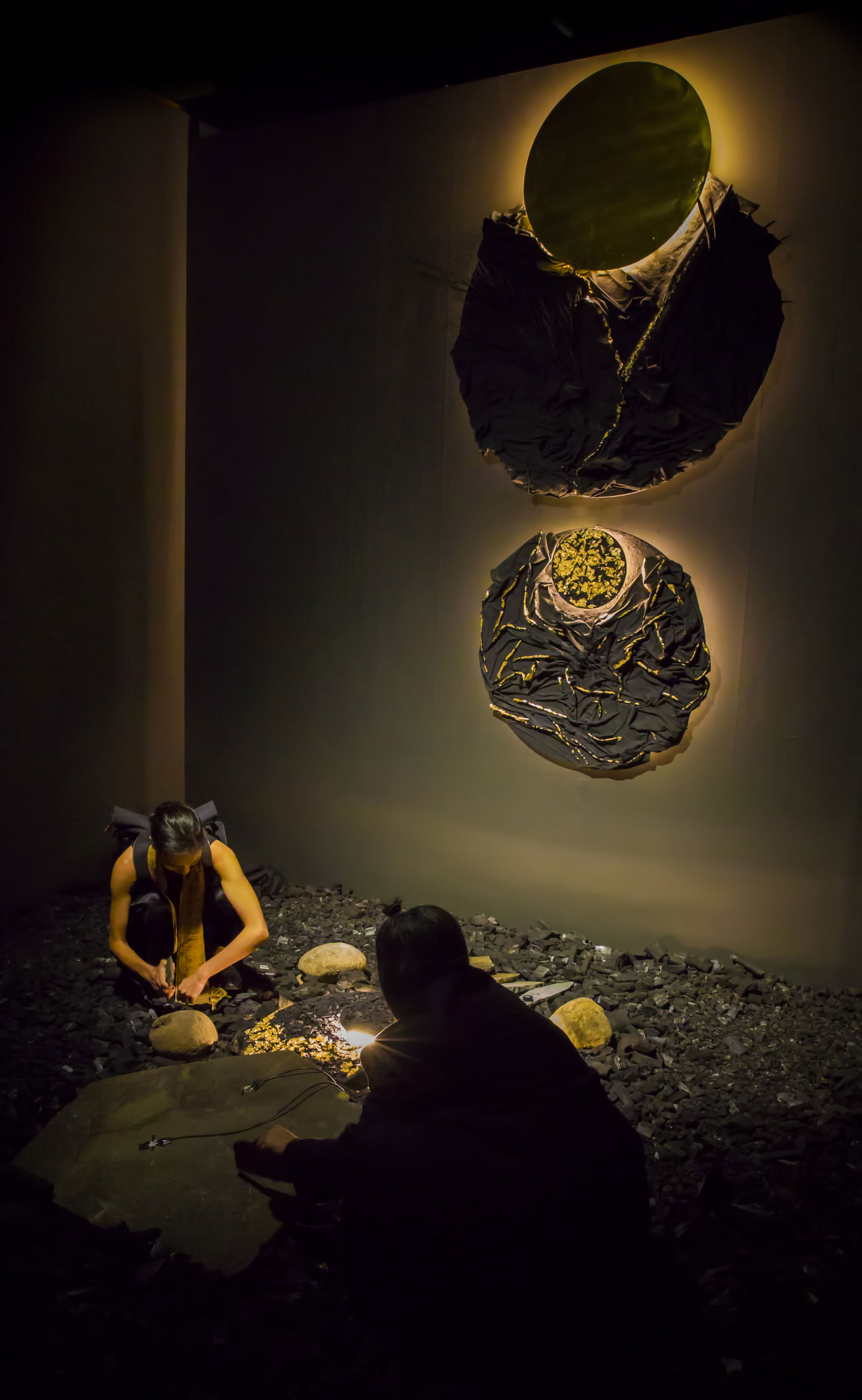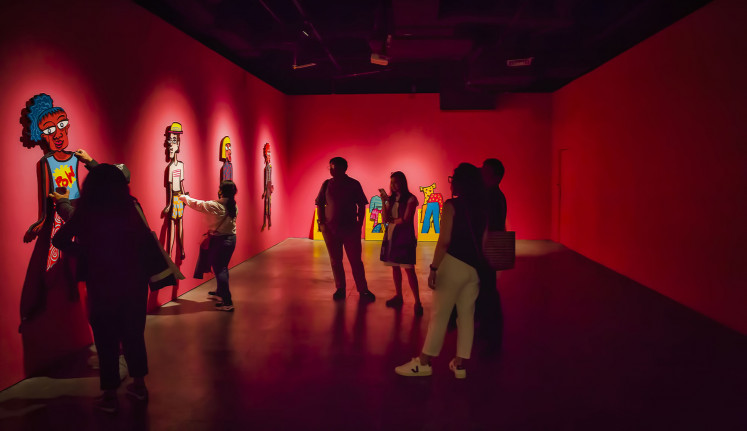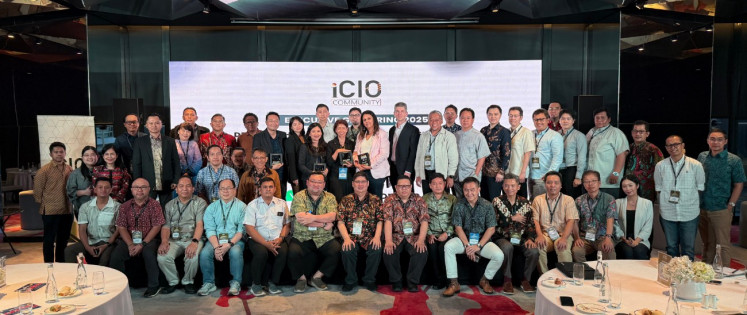Popular Reads
Top Results
Can't find what you're looking for?
View all search resultsPopular Reads
Top Results
Can't find what you're looking for?
View all search resultsArtina’s matrajiva exhibition highlights the spiritual in the individual
Change text size
Gift Premium Articles
to Anyone
T
he second edition of the artina•sarinah contemporary art exhibition seeks to strike a balance between spirituality and the material.
For some people, spirituality is often conflated with religiosity, especially in communities where piety is put on a pedestal. Historically, religion is inseparable from spirituality, though the rise of modern societies has slowly created a distinction between faith and the public.
Indonesia, with its diverse communities and cultures, has provided a rich environment for the arts to take root. Infused with an inherently spiritual population, Indonesia’s melting pot of diversity is the latest subject of artina•sarinah’s latest exhibition with the theme of matrajiva.
Held from March 4 to May 31 at the Sarinah Building in Central Jakarta, the exhibition brings together 22 artists and collectives from across disciplines to explore the spiritual aspects present in both historic and contemporary Indonesian society, featuring works by AD Pirous, Agnes Christina, Agung Kurniawan, Agus Suwage, Ahmad Sadali, Arahmaiani, Asmara Wreksono, Edward Hutabarat, Gregorius Sidharta Soegijo, I Made Somadita, Lintang Raditya, Monica Hapsari, Nadiah Bamadhaj, Natasha Tontey, Ni Nyoman Sani, Nyoman Nuarta, Riar Rizaldi, Riri Riza and Mira Lesmana, Rubi Roesli, Samuel Indratma, Widayat, as well as Yori Antar and Rumah Asuh.
Matrajiva is born from the premise of spirituality being an intrinsic part of human nature, and that the Indonesian arts scene is a manifestation of the nation’s distinctive breadth of spirituality that results from centuries of cultural value exchange and intermixing.
Beyond immersivity
A number of artworks in the exhibition highlight how factors such as culture, history and politics have played a part in the strong influence of religion in contemporary Indonesian society. Some artists express their religiosity that exists in harmony with secular values in modern art.
Though not all artists identify as spiritual individuals or take part in spiritual practices, the potential for spirituality is an innate part of them as it is a very private and individual experience.
According to curator Bob Edrian, Indonesia and its diversity lies at the core of artina•sarinah. The acculturation of traditions and values, he said, was evidence of the unique blend of Indonesian spirituality.
“Matrajiva does not only touch on spirituality in regard to a higher power and nature, but also the relationship between humans, as evident in the work by Riri Riza and Mira Lesmana. Their work highlights the figure of [poet] Chairil Anwar, which was in turn responded to by seven artists,” he told The Jakarta Post.
In terms of art media, the first iteration of artina•sarinah did not put a heavy emphasis on artworks that incorporated projection and sound. However, Bob explained, spirituality at times required media that could inspire a sense of wonder in the audience.
“I don’t like the term ‘immersive’, but we try to look for artwork that can fill up a space without filling it with objects.”
In his work Merusuara, Yogyakarta-based artist Lintang Radittya highlights the regional belief of a straight line that runs from Mount Merapi to the southern coast, but finds that the volcano is connected in a triangular formation with Mount Nglanggeran and the Early Miocene-era volcano Mount Semilir.
By using rocks and soil from Mount Merapi and Nglanggeran, Lintang created a sort of turntable emitting a sound frequency from both volcanoes that plays to the imagination and wonder, as the Semilir eruption has been noted by experts to be similar to the Toba eruption 74,000 years ago that nearly wiped out the human population.
Spirituality in the mundane
While some artworks play to the primordial, some are connected to objects and habits common in everyday life.
Asmara Wreksono’s Nona Nona harkens back to paper dolls of yore, where children could have a glimpse of mixing and matching different styles without having to raid their parents’ wardrobe. The interactive work allows visitors to dress up four individuals to their heart's content, picking and choosing various items of clothing to put on the figures.
According to Asmara, the idea behind her artwork was for viewers to be able to appreciate the process of dressing.
“For some people, every part of their clothing is thought out, from the colors to the material. But for others, their wardrobe is the last thing on their mind, whether from a lack of time, resources or even not having any sartorial interest,” she said.
As a response, Nona Nona allows visitors to do to the dolls what they may not be able to do to themselves, as the interactive nature of the artwork allows possibilities such as dressing a male doll in a bright blue sweater with a lace trim and a plaid skirt.
Asmara noted that dressing was a very personal aspect of an individual, where clothes can both signify a certain image while at the same time portraying one’s own indifference toward it.
“I want people to embrace their freedom. Take for example the male doll with the feminine clothing – some societies may frown upon this way of dressing, but this is a wonderland. To embrace this kind of thing is challenging in our society, but if you can play with it, then let’s do it.”
In the end, as spirituality is as distinctive as the individual, each visitor may come up with different interpretations and responses to each artwork.
“As curators, we can’t describe the meaning of each aspect of the artwork, as that can overwhelm the visitors. In the end, we try to present complex ideas and subjects in the humblest way so that the public can enjoy the exhibition,” Bob concluded.











